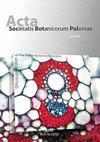Recent Developments in Taxonomy and Phylogeny of Plants
IF 1.1
4区 生物学
Q3 PLANT SCIENCES
引用次数: 0
Abstract
Modern plant taxonomy is an extensive field that is increasingly benefiting from achievements in many other fields of the biological sciences, such as genetics, cytology, molecular biology, ecology, phytogeography, and paleobotany. The influence of these branches of science on plant taxonomy is expressed not only through a significant multiplication of information and detailed data but also through new phylogenetic concepts. Reconstructing phylogenetic compounds that unite all lines of evidence is a great challenge. The process of describing a new species is considered equivalent to generating a new hypothesis in phylogenetics. Hence, taxonomy and phylogenetics are inseparably connected with each other. Advances in taxonomy and phylogenetic taxonomy have led to this special issue of Acta Societatis Botanicorum Poloniae (ASBP), bringing together 13 articles from authors who responded to our invitation and call for papers from August 2019. The current issue is the fourth themed edition of ASBP and is preceded by the special issues of the journal published in 2012 (vol. 81, issue 4), 2014 (83/4), 2016 (85/4), and 2018 (87/4). The articles in this special issue cover a wide range of topics on vascular plants, bryophytes, and plant components in lichens. We would like to thank the authors who responded to our call and submitted their interesting contributions. In the opening paper, Podani (2020) presents results of studies on iconography used for plant systematics as well as a synthesis of current knowledge about plant systematics using a modern diagrammatic approach. Cladogram topology, phylogenetic classification and nomenclature, diversity of taxonomic groups, the geological timescale, and paleontological records have, for the first time, been brought together into one figure, the Coral of Plants. Another interesting article, written by Croat and Ortiz (2020), discusses the family Araceae, the most diverse in the NewWorld tropics, but are also found in the Old World tropics and northern temperate regions. These authors focused on the evolution of the morphological and ecological characteristics of this family that have enabled it to colonize diverse habitats. High species diversity and rates of endemism as well as the presence of large numbers of unknown species constitute the principal characteristics of this family. Four of the articles consider phylogenetic relationships and divergence times of species or groups of species of vascular plants in Central Europe. Boroń et al. (2020) make an interesting contribution to a taxonomically difficult group of Angiosperms, namely, Aconitum subgen. Aconitum (Ranunculaceae), employing two independent genetic markers. These authors present hypotheses about the origin, estimated divergence time, and genetic differentiation of European and Asian diploids and tetraploids. Laczkó and Sramkó (2020) reconstruct the phylogenetic relationships and divergence times of Hepatica transsilvanica (Ranunculaceae) and its parental species. Their findings strongly support the long-term survival of H. transsilvanica in the Southeastern Carpathians. Based on their phylogeographic study of Primula vulgaris (Primulaceae), Volkova et al. (2020) show the importance of eastern refugia (the Colchis) as sources of genetic variation in European mesophilous plant speciation. The results of these three papers highlight the biogeographic importance of the Carpathians during the Quaternary glaciation periods.植物分类与系统发育研究进展
现代植物分类学是一个广泛的领域,它越来越多地受益于生物科学的许多其他领域的成就,如遗传学、细胞学、分子生物学、生态学、植物地理学和古植物学。这些科学分支对植物分类学的影响不仅通过大量的信息和详细的数据来表达,还通过新的系统发育概念来表达。重建将所有证据线结合在一起的系统发育化合物是一个巨大的挑战。在系统发育学中,描述一个新物种的过程被认为相当于产生一个新的假设。因此,分类学和系统发育学是密不可分的。分类学和系统发育分类学的进步导致了这期《波兰植物学报》(ASBP)的特刊,汇集了来自2019年8月响应我们的邀请和论文征集的作者的13篇文章。本期是ASBP的第四期主题版,之前是该杂志2012年(第81卷,第4期)、2014年(83/4)、2016年(85/4)和2018年(87/4)的特刊。这期特刊中的文章涵盖了关于维管植物、苔藓植物和地衣中植物成分的广泛主题。我们要感谢响应我们呼吁并提交了有趣贡献的作者。在开幕论文中,Podani(2020)介绍了用于植物系统学的图像学研究结果,以及使用现代图解方法对当前植物系统学知识的综合。分支图拓扑、系统发育分类和命名法、分类群的多样性、地质时间尺度和古生物记录首次被整合为一个图形,即植物珊瑚。Croat和Ortiz(2020)撰写的另一篇有趣的文章讨论了天南星科,它在新世界热带地区最为多样,但在旧世界热带和北温带地区也有发现。这些作者专注于该科形态和生态特征的进化,这些特征使其能够在不同的栖息地定居。高物种多样性和特有性以及大量未知物种的存在构成了该科的主要特征。其中四篇文章考虑了中欧维管植物物种或物种群的系统发育关系和分化时间。Boroń等人(2020)对一个分类困难的被子植物群,即乌头亚属做出了有趣的贡献。乌头属(毛茛科),采用两个独立的遗传标记。这些作者提出了关于欧洲和亚洲二倍体和四倍体的起源、估计分化时间和遗传分化的假设。Laczkó和Sramkó(2020)重建了转叶毛茛科植物Hepatica transsilvanica及其亲本物种的系统发育关系和分化时间。他们的发现有力地支持了H.transsilvanica在东南喀尔巴阡山脉的长期生存。Volkova等人(2020)根据他们对寻常报春花(报春花科)的系统地理学研究,表明了东部避难所(Colchis)作为欧洲中生植物物种形成遗传变异来源的重要性。这三篇论文的结果突出了喀尔巴阡山脉在第四纪冰川期的生物地理学重要性。
本文章由计算机程序翻译,如有差异,请以英文原文为准。
求助全文
约1分钟内获得全文
求助全文
来源期刊
CiteScore
2.00
自引率
10.00%
发文量
18
审稿时长
1 months
期刊介绍:
The journal has been published since 1923 and offers Open Access publication of original research papers, short communications, and reviews in all areas of plant science, including evolution, ecology, genetics, plant structure and development, physiology and biochemistry.

 求助内容:
求助内容: 应助结果提醒方式:
应助结果提醒方式:


